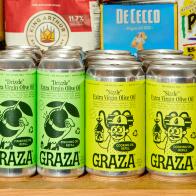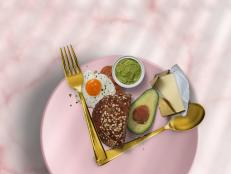Talking to Manuel Villacorta, Author of Flat Belly 365

One of the most popular New Year’s resolutions is always to lose weight. This year, Manuel Villacorta’s new cookbook, Flat Belly 365: The Gut-Friendly Superfood Plan to Shed Pounds, Fight Inflammation, and Feel Great All Year Long has arrived just in time to help us all reach out healthy goals. I talked to the award-winning dietitian about his new book, and asked him to share a recipe from his new book.
Heathy Eats: Who will benefit from your new cookbook?
Villacorta: Both men and women who are not only looking to reduce their belly fat, but also prevent chronic diseases and keep their gut healthy. It can also benefit those who want step-by-step instructions such as meal plans, shopping lists and recipes.
How is gut health and weight loss related?
There is a growing body of evidence that the right combination of gut bacteria can cause changes in a person’s weight. Researchers can now identify an individual as obese or lean just by looking at their gut bacteria. Several studies have even transplanted gut bacteria from obese mice into lean mice, which resulted in weight gained without any changes in their diet and exercise. The same result occurred when the microbiome of lean mice was transplanted into obese mice; they lost weight.
How can we keep our guts healthy?
Diet quality has a lot to do with gut health, and eating both probiotics and prebiotics will keep your gut both happy and healthy. Probiotics are the good type of bacteria that are live, active organisms that help keep the digestive system happy and healthy. The more probiotics in our gastrointestinal system, the healthier our microbiome. And a healthy microbiome means a lower risk if chronic diseases such as low immunity, type 2 diabetes, gastrointestinal disorders and even depression, among others. Probiotics can be found in fermented foods such a yogurt, kefir and other fermented foods like kimchi and sauerkraut.
Prebiotics are the fuel to help probiotics thrive and multiply. Prebiotics are fibers found in foods such as avocados, sweet potatoes, oatmeal, onions, garlic and leeks, among others.
What are a few of the 365 flat belly principles?
There are three main concepts of the book. One is tackling visceral fat with anti-inflammatory fats and superfoods. Second is keeping your gut healthy, which can help reduce weight and prevent other chronic diseases. The third is reducing inflammation by eating anti-inflammatory superfoods.

Walnut Pesto Quinoa Bowl
Recipe courtesy of Manuel Villacorta and Flat Belly 365
Servings: 4
Serving Size: 1⁄2 cup quinoa and 1 tablespoon pesto
Ingredients
For the quinoa:
1 cup red quinoa, raw
1¾ cups vegetable stock
1 cup red bell pepper, diced small
1⁄2 teaspoon sea salt
1 poached egg, for garnish
For the pesto:
1 tablespoon olive oil
1⁄4 cup red onion, diced
3 cups spinach
2–3 leaves basil
1 tablespoon lemon juice
1⁄4 cup vegetable stock
1⁄4 cup walnuts, chopped
1⁄2 teaspoon sea salt
1⁄4 teaspoon black pepper
Directions:
- For quinoa: In a small saucepan, place the quinoa, vegetable stock, red bell pepper, and sea salt. Bring it up to a boil, then simmer. Cook for 15 minutes or until the quinoa is cooked. Set aside and cool.
- For pesto: In a small sauté́ pan on medium-high heat, place the olive oil and heat for 1 minute. Add the onion and cook for 3 to 5 minutes or until the onion becomes translucent. Remove from the pan and place in a blender.
- Add the spinach, basil, lemon juice, vegetable stock, walnuts, salt, and black pepper to the blender. Puree until the mixture reaches a smooth, thick consistency.
- Place the quinoa mixture in a medium-sized bowl. Add 4 tablespoons of the pesto to the bowl and mix thoroughly. Place a poached egg on top.
- Refrigerate remaining pesto for later use. It keeps for up to 5 days.
Note: For every 1⁄2 cup of quinoa, add 1 tablespoon of pesto.
Nutrition information (per serving):
Quinoa (1/2 cup serving):
Kcal 215, Protein 9 g, Carb 31 g, Fat 7 g, Sodium 578 mg, Dietary Fiber 4 g,
Daily Values: Fiber 15%, Vitamin C 56%, Vitamin A 13%, Vitamin D 1%, Potassium 9%, Calcium 3%, Iron 15% For pesto only
Pesto (1 tablespoon serving; yield: 12 servings)
Kcal 29, Protein 1g, Carb 1g, Fat 3g, Sodium 80mg, Dietary Fiber 0g,
Daily Values: Fiber 1%, Vitamin C 3%, Vitamin A 4%, Vitamin D 0%, Potassium 1%, Calcium 1%, Iron 2%


































